Smoking and Pregnancy: Risks, Interventions, and Healthcare Settings
VerifiedAdded on 2022/08/26
|8
|2380
|15
Report
AI Summary
This report addresses the critical issue of smoking during pregnancy, detailing the various complications that can arise for both the mother and the unborn child. It highlights the dangers of nicotine, carbon monoxide, and other gases entering the mother's bloodstream and reaching the baby, potentially leading to miscarriage, impaired cognitive and mental development, and sudden infant death. The report aims to identify the reasons behind smoking among pregnant women and propose effective models and settings to facilitate smoking cessation. It emphasizes the importance of prenatal care, including guidance from nurses and healthcare professionals, and the integration of clinical staff to support mothers. The rationale behind the approach is to raise awareness of the risks associated with smoking, encourage self-reported cessation, and provide continuous monitoring and training to promote healthy habits. The report also discusses the importance of teamwork and interdisciplinary collaboration within healthcare settings to improve the quality of care and outcomes for both mothers and their babies.

Running Head: HEALTHCARE
HEALTHCARE
Name of the student
Name of the university
Author note
HEALTHCARE
Name of the student
Name of the university
Author note
Paraphrase This Document
Need a fresh take? Get an instant paraphrase of this document with our AI Paraphraser
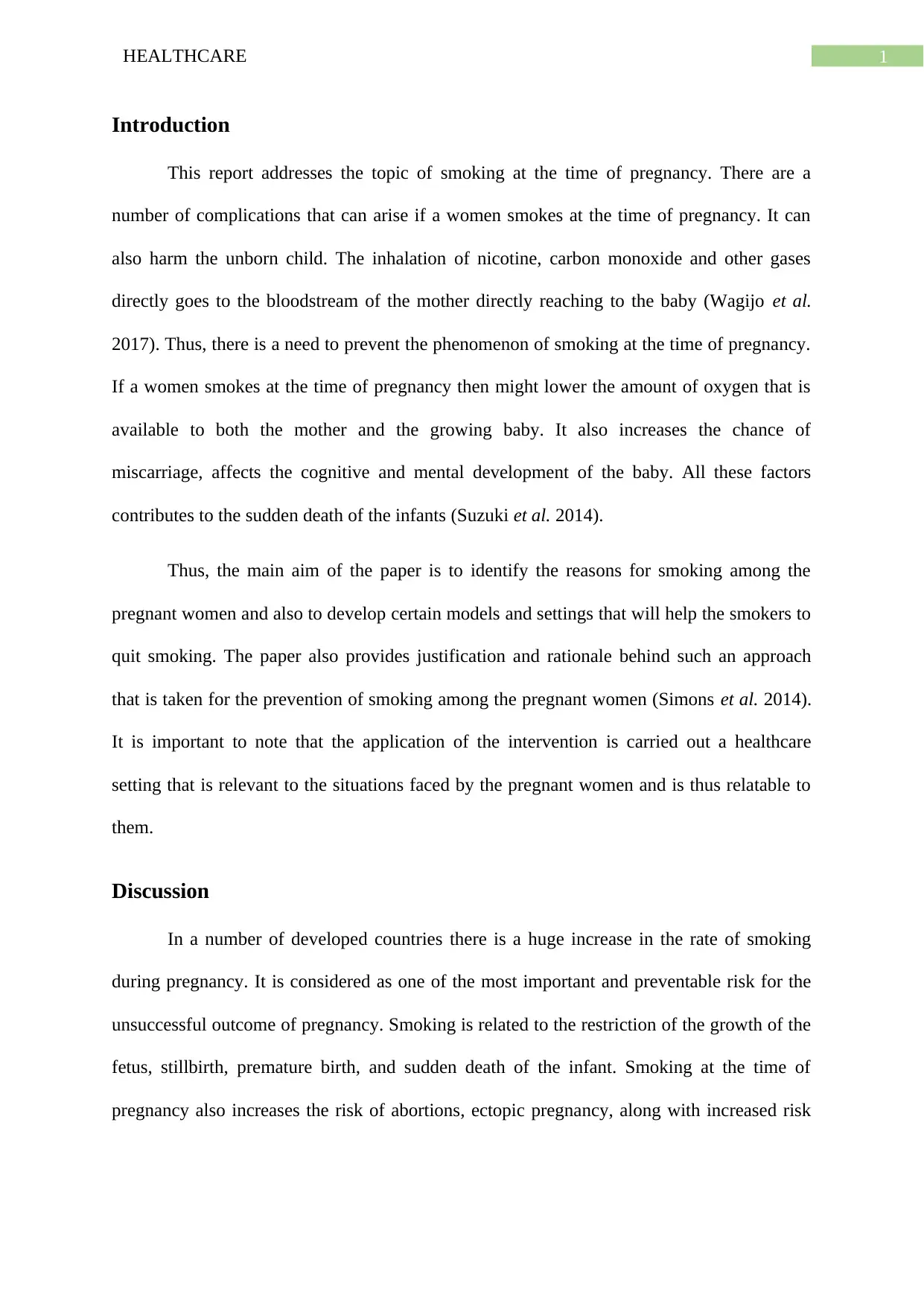
1HEALTHCARE
Introduction
This report addresses the topic of smoking at the time of pregnancy. There are a
number of complications that can arise if a women smokes at the time of pregnancy. It can
also harm the unborn child. The inhalation of nicotine, carbon monoxide and other gases
directly goes to the bloodstream of the mother directly reaching to the baby (Wagijo et al.
2017). Thus, there is a need to prevent the phenomenon of smoking at the time of pregnancy.
If a women smokes at the time of pregnancy then might lower the amount of oxygen that is
available to both the mother and the growing baby. It also increases the chance of
miscarriage, affects the cognitive and mental development of the baby. All these factors
contributes to the sudden death of the infants (Suzuki et al. 2014).
Thus, the main aim of the paper is to identify the reasons for smoking among the
pregnant women and also to develop certain models and settings that will help the smokers to
quit smoking. The paper also provides justification and rationale behind such an approach
that is taken for the prevention of smoking among the pregnant women (Simons et al. 2014).
It is important to note that the application of the intervention is carried out a healthcare
setting that is relevant to the situations faced by the pregnant women and is thus relatable to
them.
Discussion
In a number of developed countries there is a huge increase in the rate of smoking
during pregnancy. It is considered as one of the most important and preventable risk for the
unsuccessful outcome of pregnancy. Smoking is related to the restriction of the growth of the
fetus, stillbirth, premature birth, and sudden death of the infant. Smoking at the time of
pregnancy also increases the risk of abortions, ectopic pregnancy, along with increased risk
Introduction
This report addresses the topic of smoking at the time of pregnancy. There are a
number of complications that can arise if a women smokes at the time of pregnancy. It can
also harm the unborn child. The inhalation of nicotine, carbon monoxide and other gases
directly goes to the bloodstream of the mother directly reaching to the baby (Wagijo et al.
2017). Thus, there is a need to prevent the phenomenon of smoking at the time of pregnancy.
If a women smokes at the time of pregnancy then might lower the amount of oxygen that is
available to both the mother and the growing baby. It also increases the chance of
miscarriage, affects the cognitive and mental development of the baby. All these factors
contributes to the sudden death of the infants (Suzuki et al. 2014).
Thus, the main aim of the paper is to identify the reasons for smoking among the
pregnant women and also to develop certain models and settings that will help the smokers to
quit smoking. The paper also provides justification and rationale behind such an approach
that is taken for the prevention of smoking among the pregnant women (Simons et al. 2014).
It is important to note that the application of the intervention is carried out a healthcare
setting that is relevant to the situations faced by the pregnant women and is thus relatable to
them.
Discussion
In a number of developed countries there is a huge increase in the rate of smoking
during pregnancy. It is considered as one of the most important and preventable risk for the
unsuccessful outcome of pregnancy. Smoking is related to the restriction of the growth of the
fetus, stillbirth, premature birth, and sudden death of the infant. Smoking at the time of
pregnancy also increases the risk of abortions, ectopic pregnancy, along with increased risk
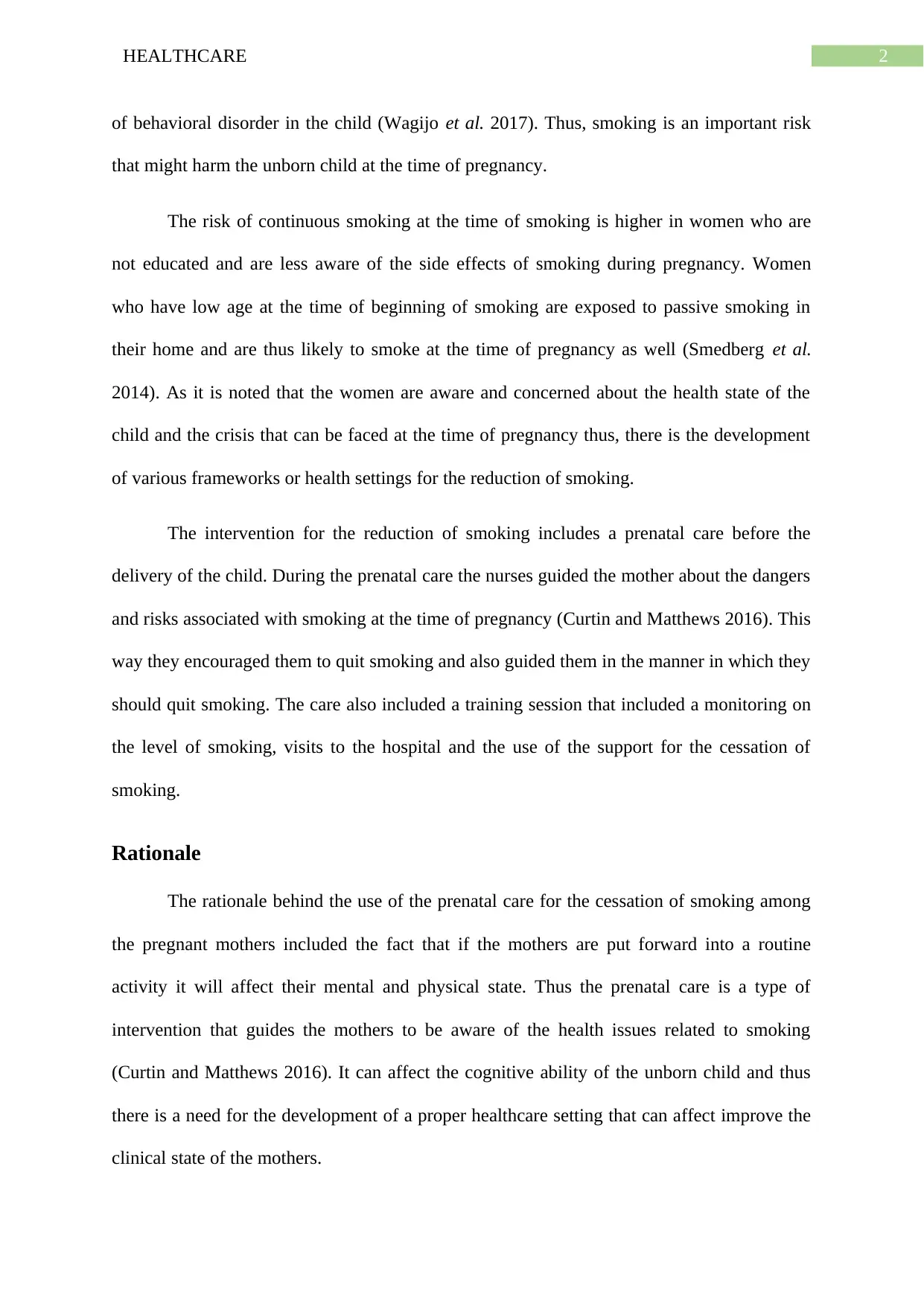
2HEALTHCARE
of behavioral disorder in the child (Wagijo et al. 2017). Thus, smoking is an important risk
that might harm the unborn child at the time of pregnancy.
The risk of continuous smoking at the time of smoking is higher in women who are
not educated and are less aware of the side effects of smoking during pregnancy. Women
who have low age at the time of beginning of smoking are exposed to passive smoking in
their home and are thus likely to smoke at the time of pregnancy as well (Smedberg et al.
2014). As it is noted that the women are aware and concerned about the health state of the
child and the crisis that can be faced at the time of pregnancy thus, there is the development
of various frameworks or health settings for the reduction of smoking.
The intervention for the reduction of smoking includes a prenatal care before the
delivery of the child. During the prenatal care the nurses guided the mother about the dangers
and risks associated with smoking at the time of pregnancy (Curtin and Matthews 2016). This
way they encouraged them to quit smoking and also guided them in the manner in which they
should quit smoking. The care also included a training session that included a monitoring on
the level of smoking, visits to the hospital and the use of the support for the cessation of
smoking.
Rationale
The rationale behind the use of the prenatal care for the cessation of smoking among
the pregnant mothers included the fact that if the mothers are put forward into a routine
activity it will affect their mental and physical state. Thus the prenatal care is a type of
intervention that guides the mothers to be aware of the health issues related to smoking
(Curtin and Matthews 2016). It can affect the cognitive ability of the unborn child and thus
there is a need for the development of a proper healthcare setting that can affect improve the
clinical state of the mothers.
of behavioral disorder in the child (Wagijo et al. 2017). Thus, smoking is an important risk
that might harm the unborn child at the time of pregnancy.
The risk of continuous smoking at the time of smoking is higher in women who are
not educated and are less aware of the side effects of smoking during pregnancy. Women
who have low age at the time of beginning of smoking are exposed to passive smoking in
their home and are thus likely to smoke at the time of pregnancy as well (Smedberg et al.
2014). As it is noted that the women are aware and concerned about the health state of the
child and the crisis that can be faced at the time of pregnancy thus, there is the development
of various frameworks or health settings for the reduction of smoking.
The intervention for the reduction of smoking includes a prenatal care before the
delivery of the child. During the prenatal care the nurses guided the mother about the dangers
and risks associated with smoking at the time of pregnancy (Curtin and Matthews 2016). This
way they encouraged them to quit smoking and also guided them in the manner in which they
should quit smoking. The care also included a training session that included a monitoring on
the level of smoking, visits to the hospital and the use of the support for the cessation of
smoking.
Rationale
The rationale behind the use of the prenatal care for the cessation of smoking among
the pregnant mothers included the fact that if the mothers are put forward into a routine
activity it will affect their mental and physical state. Thus the prenatal care is a type of
intervention that guides the mothers to be aware of the health issues related to smoking
(Curtin and Matthews 2016). It can affect the cognitive ability of the unborn child and thus
there is a need for the development of a proper healthcare setting that can affect improve the
clinical state of the mothers.
⊘ This is a preview!⊘
Do you want full access?
Subscribe today to unlock all pages.

Trusted by 1+ million students worldwide
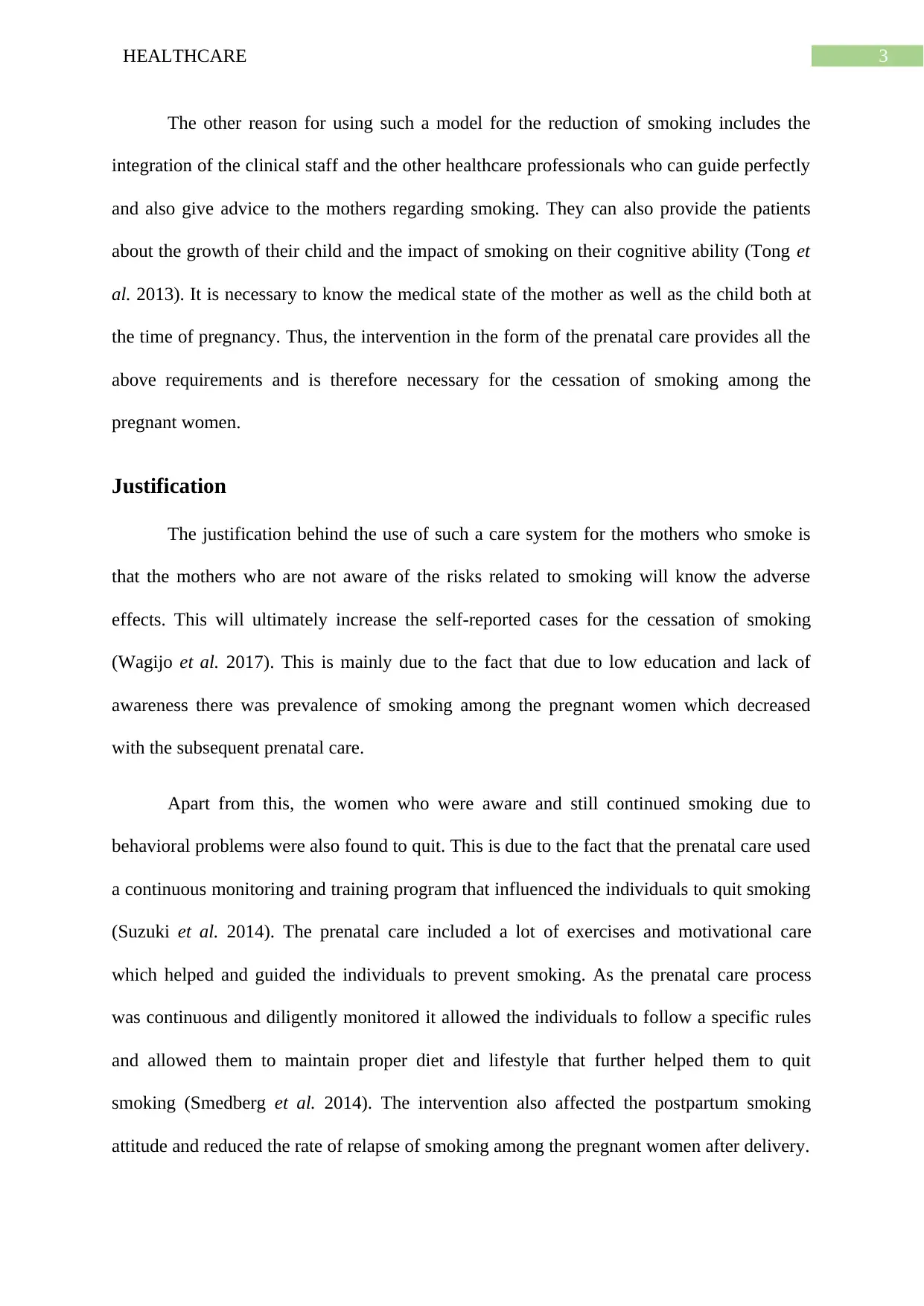
3HEALTHCARE
The other reason for using such a model for the reduction of smoking includes the
integration of the clinical staff and the other healthcare professionals who can guide perfectly
and also give advice to the mothers regarding smoking. They can also provide the patients
about the growth of their child and the impact of smoking on their cognitive ability (Tong et
al. 2013). It is necessary to know the medical state of the mother as well as the child both at
the time of pregnancy. Thus, the intervention in the form of the prenatal care provides all the
above requirements and is therefore necessary for the cessation of smoking among the
pregnant women.
Justification
The justification behind the use of such a care system for the mothers who smoke is
that the mothers who are not aware of the risks related to smoking will know the adverse
effects. This will ultimately increase the self-reported cases for the cessation of smoking
(Wagijo et al. 2017). This is mainly due to the fact that due to low education and lack of
awareness there was prevalence of smoking among the pregnant women which decreased
with the subsequent prenatal care.
Apart from this, the women who were aware and still continued smoking due to
behavioral problems were also found to quit. This is due to the fact that the prenatal care used
a continuous monitoring and training program that influenced the individuals to quit smoking
(Suzuki et al. 2014). The prenatal care included a lot of exercises and motivational care
which helped and guided the individuals to prevent smoking. As the prenatal care process
was continuous and diligently monitored it allowed the individuals to follow a specific rules
and allowed them to maintain proper diet and lifestyle that further helped them to quit
smoking (Smedberg et al. 2014). The intervention also affected the postpartum smoking
attitude and reduced the rate of relapse of smoking among the pregnant women after delivery.
The other reason for using such a model for the reduction of smoking includes the
integration of the clinical staff and the other healthcare professionals who can guide perfectly
and also give advice to the mothers regarding smoking. They can also provide the patients
about the growth of their child and the impact of smoking on their cognitive ability (Tong et
al. 2013). It is necessary to know the medical state of the mother as well as the child both at
the time of pregnancy. Thus, the intervention in the form of the prenatal care provides all the
above requirements and is therefore necessary for the cessation of smoking among the
pregnant women.
Justification
The justification behind the use of such a care system for the mothers who smoke is
that the mothers who are not aware of the risks related to smoking will know the adverse
effects. This will ultimately increase the self-reported cases for the cessation of smoking
(Wagijo et al. 2017). This is mainly due to the fact that due to low education and lack of
awareness there was prevalence of smoking among the pregnant women which decreased
with the subsequent prenatal care.
Apart from this, the women who were aware and still continued smoking due to
behavioral problems were also found to quit. This is due to the fact that the prenatal care used
a continuous monitoring and training program that influenced the individuals to quit smoking
(Suzuki et al. 2014). The prenatal care included a lot of exercises and motivational care
which helped and guided the individuals to prevent smoking. As the prenatal care process
was continuous and diligently monitored it allowed the individuals to follow a specific rules
and allowed them to maintain proper diet and lifestyle that further helped them to quit
smoking (Smedberg et al. 2014). The intervention also affected the postpartum smoking
attitude and reduced the rate of relapse of smoking among the pregnant women after delivery.
Paraphrase This Document
Need a fresh take? Get an instant paraphrase of this document with our AI Paraphraser
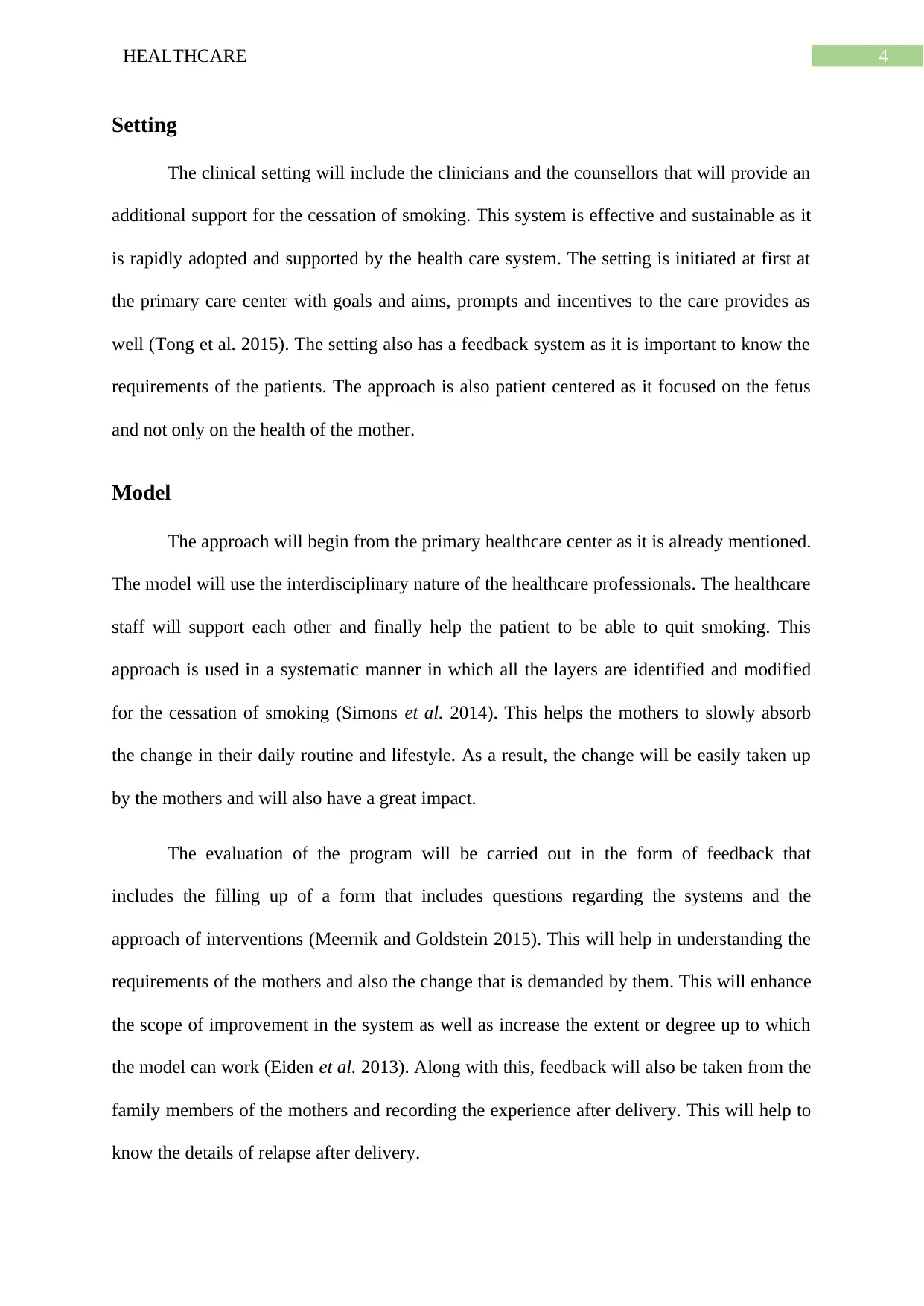
4HEALTHCARE
Setting
The clinical setting will include the clinicians and the counsellors that will provide an
additional support for the cessation of smoking. This system is effective and sustainable as it
is rapidly adopted and supported by the health care system. The setting is initiated at first at
the primary care center with goals and aims, prompts and incentives to the care provides as
well (Tong et al. 2015). The setting also has a feedback system as it is important to know the
requirements of the patients. The approach is also patient centered as it focused on the fetus
and not only on the health of the mother.
Model
The approach will begin from the primary healthcare center as it is already mentioned.
The model will use the interdisciplinary nature of the healthcare professionals. The healthcare
staff will support each other and finally help the patient to be able to quit smoking. This
approach is used in a systematic manner in which all the layers are identified and modified
for the cessation of smoking (Simons et al. 2014). This helps the mothers to slowly absorb
the change in their daily routine and lifestyle. As a result, the change will be easily taken up
by the mothers and will also have a great impact.
The evaluation of the program will be carried out in the form of feedback that
includes the filling up of a form that includes questions regarding the systems and the
approach of interventions (Meernik and Goldstein 2015). This will help in understanding the
requirements of the mothers and also the change that is demanded by them. This will enhance
the scope of improvement in the system as well as increase the extent or degree up to which
the model can work (Eiden et al. 2013). Along with this, feedback will also be taken from the
family members of the mothers and recording the experience after delivery. This will help to
know the details of relapse after delivery.
Setting
The clinical setting will include the clinicians and the counsellors that will provide an
additional support for the cessation of smoking. This system is effective and sustainable as it
is rapidly adopted and supported by the health care system. The setting is initiated at first at
the primary care center with goals and aims, prompts and incentives to the care provides as
well (Tong et al. 2015). The setting also has a feedback system as it is important to know the
requirements of the patients. The approach is also patient centered as it focused on the fetus
and not only on the health of the mother.
Model
The approach will begin from the primary healthcare center as it is already mentioned.
The model will use the interdisciplinary nature of the healthcare professionals. The healthcare
staff will support each other and finally help the patient to be able to quit smoking. This
approach is used in a systematic manner in which all the layers are identified and modified
for the cessation of smoking (Simons et al. 2014). This helps the mothers to slowly absorb
the change in their daily routine and lifestyle. As a result, the change will be easily taken up
by the mothers and will also have a great impact.
The evaluation of the program will be carried out in the form of feedback that
includes the filling up of a form that includes questions regarding the systems and the
approach of interventions (Meernik and Goldstein 2015). This will help in understanding the
requirements of the mothers and also the change that is demanded by them. This will enhance
the scope of improvement in the system as well as increase the extent or degree up to which
the model can work (Eiden et al. 2013). Along with this, feedback will also be taken from the
family members of the mothers and recording the experience after delivery. This will help to
know the details of relapse after delivery.
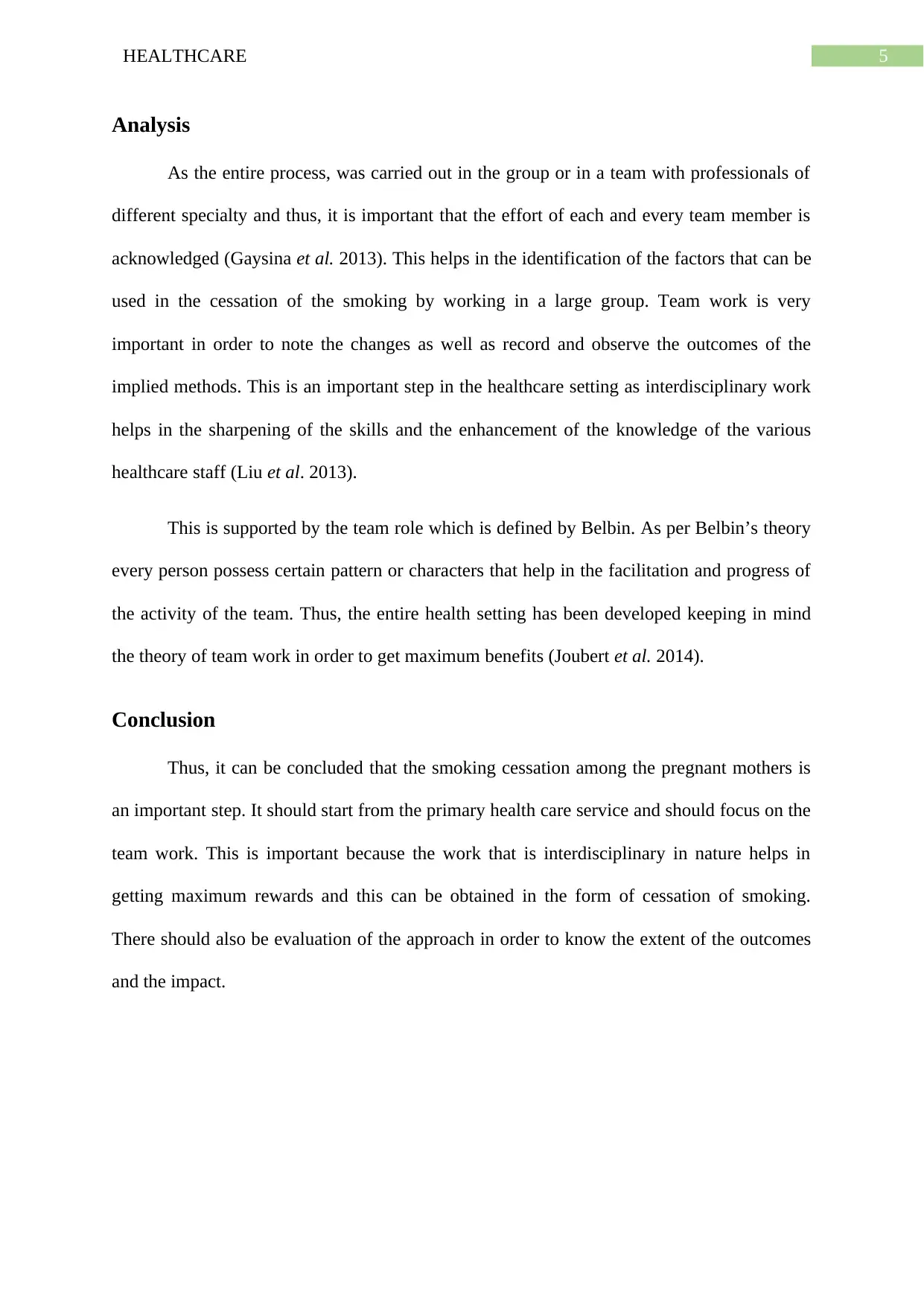
5HEALTHCARE
Analysis
As the entire process, was carried out in the group or in a team with professionals of
different specialty and thus, it is important that the effort of each and every team member is
acknowledged (Gaysina et al. 2013). This helps in the identification of the factors that can be
used in the cessation of the smoking by working in a large group. Team work is very
important in order to note the changes as well as record and observe the outcomes of the
implied methods. This is an important step in the healthcare setting as interdisciplinary work
helps in the sharpening of the skills and the enhancement of the knowledge of the various
healthcare staff (Liu et al. 2013).
This is supported by the team role which is defined by Belbin. As per Belbin’s theory
every person possess certain pattern or characters that help in the facilitation and progress of
the activity of the team. Thus, the entire health setting has been developed keeping in mind
the theory of team work in order to get maximum benefits (Joubert et al. 2014).
Conclusion
Thus, it can be concluded that the smoking cessation among the pregnant mothers is
an important step. It should start from the primary health care service and should focus on the
team work. This is important because the work that is interdisciplinary in nature helps in
getting maximum rewards and this can be obtained in the form of cessation of smoking.
There should also be evaluation of the approach in order to know the extent of the outcomes
and the impact.
Analysis
As the entire process, was carried out in the group or in a team with professionals of
different specialty and thus, it is important that the effort of each and every team member is
acknowledged (Gaysina et al. 2013). This helps in the identification of the factors that can be
used in the cessation of the smoking by working in a large group. Team work is very
important in order to note the changes as well as record and observe the outcomes of the
implied methods. This is an important step in the healthcare setting as interdisciplinary work
helps in the sharpening of the skills and the enhancement of the knowledge of the various
healthcare staff (Liu et al. 2013).
This is supported by the team role which is defined by Belbin. As per Belbin’s theory
every person possess certain pattern or characters that help in the facilitation and progress of
the activity of the team. Thus, the entire health setting has been developed keeping in mind
the theory of team work in order to get maximum benefits (Joubert et al. 2014).
Conclusion
Thus, it can be concluded that the smoking cessation among the pregnant mothers is
an important step. It should start from the primary health care service and should focus on the
team work. This is important because the work that is interdisciplinary in nature helps in
getting maximum rewards and this can be obtained in the form of cessation of smoking.
There should also be evaluation of the approach in order to know the extent of the outcomes
and the impact.
⊘ This is a preview!⊘
Do you want full access?
Subscribe today to unlock all pages.

Trusted by 1+ million students worldwide
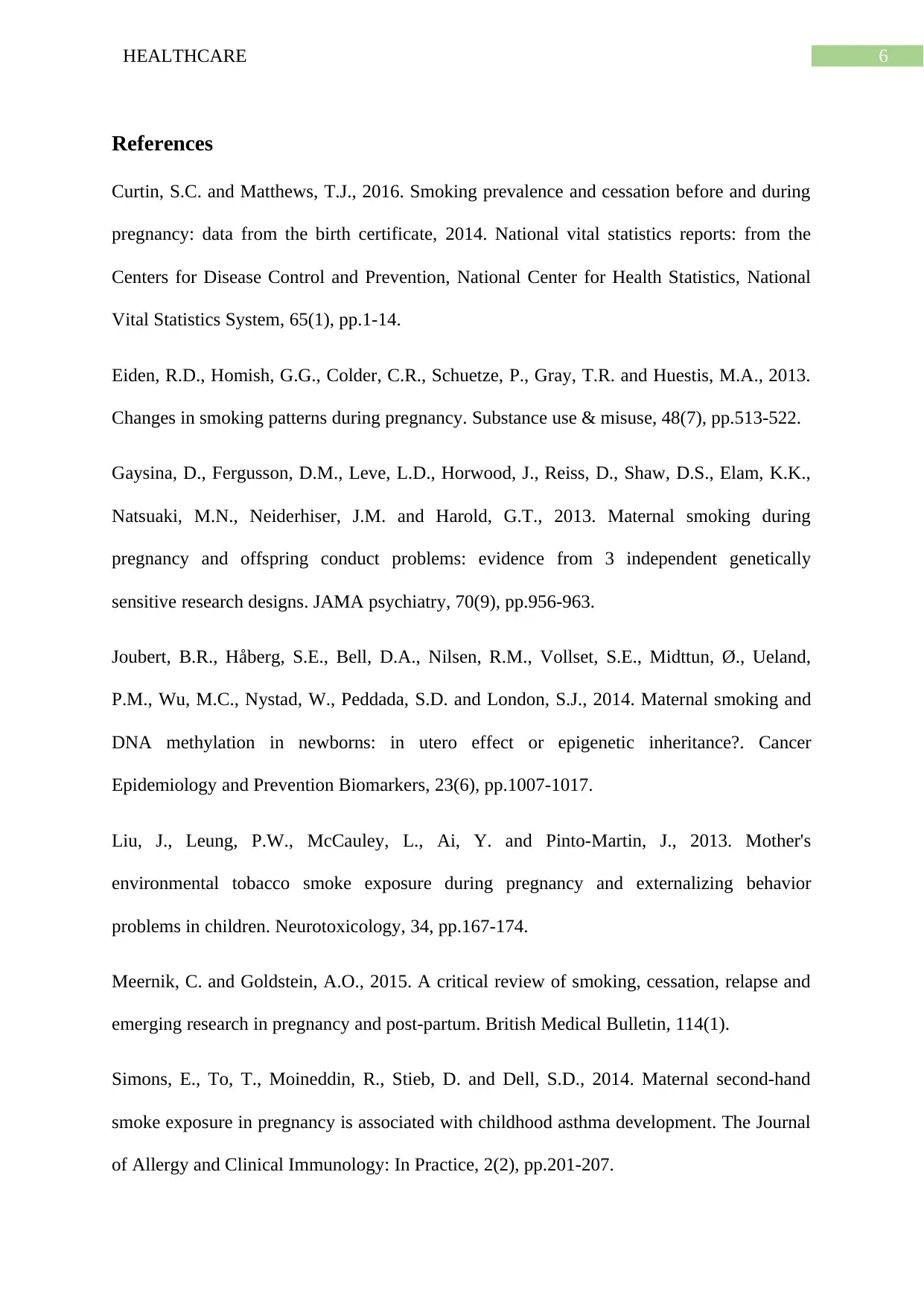
6HEALTHCARE
References
Curtin, S.C. and Matthews, T.J., 2016. Smoking prevalence and cessation before and during
pregnancy: data from the birth certificate, 2014. National vital statistics reports: from the
Centers for Disease Control and Prevention, National Center for Health Statistics, National
Vital Statistics System, 65(1), pp.1-14.
Eiden, R.D., Homish, G.G., Colder, C.R., Schuetze, P., Gray, T.R. and Huestis, M.A., 2013.
Changes in smoking patterns during pregnancy. Substance use & misuse, 48(7), pp.513-522.
Gaysina, D., Fergusson, D.M., Leve, L.D., Horwood, J., Reiss, D., Shaw, D.S., Elam, K.K.,
Natsuaki, M.N., Neiderhiser, J.M. and Harold, G.T., 2013. Maternal smoking during
pregnancy and offspring conduct problems: evidence from 3 independent genetically
sensitive research designs. JAMA psychiatry, 70(9), pp.956-963.
Joubert, B.R., Håberg, S.E., Bell, D.A., Nilsen, R.M., Vollset, S.E., Midttun, Ø., Ueland,
P.M., Wu, M.C., Nystad, W., Peddada, S.D. and London, S.J., 2014. Maternal smoking and
DNA methylation in newborns: in utero effect or epigenetic inheritance?. Cancer
Epidemiology and Prevention Biomarkers, 23(6), pp.1007-1017.
Liu, J., Leung, P.W., McCauley, L., Ai, Y. and Pinto-Martin, J., 2013. Mother's
environmental tobacco smoke exposure during pregnancy and externalizing behavior
problems in children. Neurotoxicology, 34, pp.167-174.
Meernik, C. and Goldstein, A.O., 2015. A critical review of smoking, cessation, relapse and
emerging research in pregnancy and post-partum. British Medical Bulletin, 114(1).
Simons, E., To, T., Moineddin, R., Stieb, D. and Dell, S.D., 2014. Maternal second-hand
smoke exposure in pregnancy is associated with childhood asthma development. The Journal
of Allergy and Clinical Immunology: In Practice, 2(2), pp.201-207.
References
Curtin, S.C. and Matthews, T.J., 2016. Smoking prevalence and cessation before and during
pregnancy: data from the birth certificate, 2014. National vital statistics reports: from the
Centers for Disease Control and Prevention, National Center for Health Statistics, National
Vital Statistics System, 65(1), pp.1-14.
Eiden, R.D., Homish, G.G., Colder, C.R., Schuetze, P., Gray, T.R. and Huestis, M.A., 2013.
Changes in smoking patterns during pregnancy. Substance use & misuse, 48(7), pp.513-522.
Gaysina, D., Fergusson, D.M., Leve, L.D., Horwood, J., Reiss, D., Shaw, D.S., Elam, K.K.,
Natsuaki, M.N., Neiderhiser, J.M. and Harold, G.T., 2013. Maternal smoking during
pregnancy and offspring conduct problems: evidence from 3 independent genetically
sensitive research designs. JAMA psychiatry, 70(9), pp.956-963.
Joubert, B.R., Håberg, S.E., Bell, D.A., Nilsen, R.M., Vollset, S.E., Midttun, Ø., Ueland,
P.M., Wu, M.C., Nystad, W., Peddada, S.D. and London, S.J., 2014. Maternal smoking and
DNA methylation in newborns: in utero effect or epigenetic inheritance?. Cancer
Epidemiology and Prevention Biomarkers, 23(6), pp.1007-1017.
Liu, J., Leung, P.W., McCauley, L., Ai, Y. and Pinto-Martin, J., 2013. Mother's
environmental tobacco smoke exposure during pregnancy and externalizing behavior
problems in children. Neurotoxicology, 34, pp.167-174.
Meernik, C. and Goldstein, A.O., 2015. A critical review of smoking, cessation, relapse and
emerging research in pregnancy and post-partum. British Medical Bulletin, 114(1).
Simons, E., To, T., Moineddin, R., Stieb, D. and Dell, S.D., 2014. Maternal second-hand
smoke exposure in pregnancy is associated with childhood asthma development. The Journal
of Allergy and Clinical Immunology: In Practice, 2(2), pp.201-207.
Paraphrase This Document
Need a fresh take? Get an instant paraphrase of this document with our AI Paraphraser
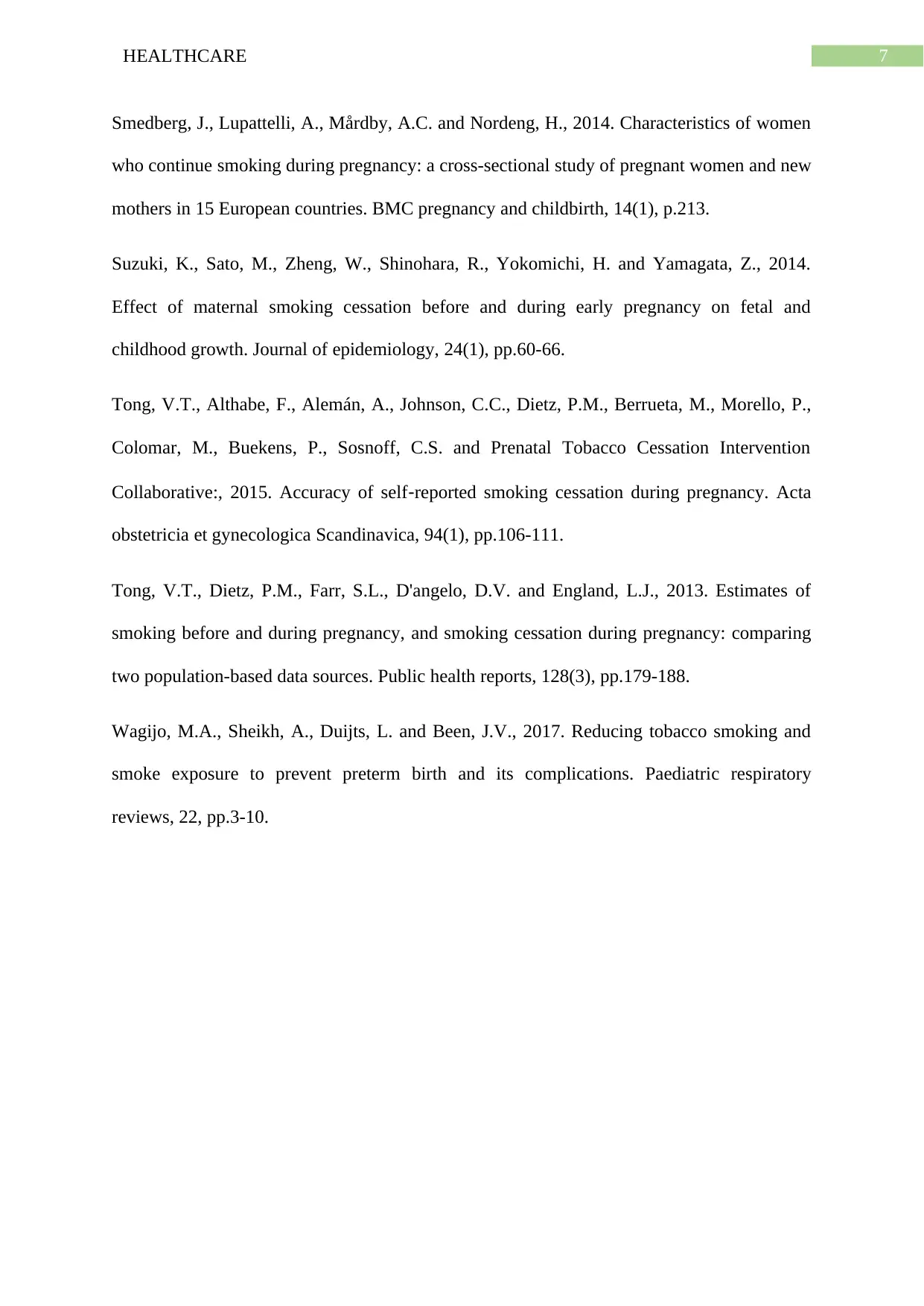
7HEALTHCARE
Smedberg, J., Lupattelli, A., Mårdby, A.C. and Nordeng, H., 2014. Characteristics of women
who continue smoking during pregnancy: a cross-sectional study of pregnant women and new
mothers in 15 European countries. BMC pregnancy and childbirth, 14(1), p.213.
Suzuki, K., Sato, M., Zheng, W., Shinohara, R., Yokomichi, H. and Yamagata, Z., 2014.
Effect of maternal smoking cessation before and during early pregnancy on fetal and
childhood growth. Journal of epidemiology, 24(1), pp.60-66.
Tong, V.T., Althabe, F., Alemán, A., Johnson, C.C., Dietz, P.M., Berrueta, M., Morello, P.,
Colomar, M., Buekens, P., Sosnoff, C.S. and Prenatal Tobacco Cessation Intervention
Collaborative:, 2015. Accuracy of self‐reported smoking cessation during pregnancy. Acta
obstetricia et gynecologica Scandinavica, 94(1), pp.106-111.
Tong, V.T., Dietz, P.M., Farr, S.L., D'angelo, D.V. and England, L.J., 2013. Estimates of
smoking before and during pregnancy, and smoking cessation during pregnancy: comparing
two population-based data sources. Public health reports, 128(3), pp.179-188.
Wagijo, M.A., Sheikh, A., Duijts, L. and Been, J.V., 2017. Reducing tobacco smoking and
smoke exposure to prevent preterm birth and its complications. Paediatric respiratory
reviews, 22, pp.3-10.
Smedberg, J., Lupattelli, A., Mårdby, A.C. and Nordeng, H., 2014. Characteristics of women
who continue smoking during pregnancy: a cross-sectional study of pregnant women and new
mothers in 15 European countries. BMC pregnancy and childbirth, 14(1), p.213.
Suzuki, K., Sato, M., Zheng, W., Shinohara, R., Yokomichi, H. and Yamagata, Z., 2014.
Effect of maternal smoking cessation before and during early pregnancy on fetal and
childhood growth. Journal of epidemiology, 24(1), pp.60-66.
Tong, V.T., Althabe, F., Alemán, A., Johnson, C.C., Dietz, P.M., Berrueta, M., Morello, P.,
Colomar, M., Buekens, P., Sosnoff, C.S. and Prenatal Tobacco Cessation Intervention
Collaborative:, 2015. Accuracy of self‐reported smoking cessation during pregnancy. Acta
obstetricia et gynecologica Scandinavica, 94(1), pp.106-111.
Tong, V.T., Dietz, P.M., Farr, S.L., D'angelo, D.V. and England, L.J., 2013. Estimates of
smoking before and during pregnancy, and smoking cessation during pregnancy: comparing
two population-based data sources. Public health reports, 128(3), pp.179-188.
Wagijo, M.A., Sheikh, A., Duijts, L. and Been, J.V., 2017. Reducing tobacco smoking and
smoke exposure to prevent preterm birth and its complications. Paediatric respiratory
reviews, 22, pp.3-10.
1 out of 8
Related Documents
Your All-in-One AI-Powered Toolkit for Academic Success.
+13062052269
info@desklib.com
Available 24*7 on WhatsApp / Email
![[object Object]](/_next/static/media/star-bottom.7253800d.svg)
Unlock your academic potential
Copyright © 2020–2025 A2Z Services. All Rights Reserved. Developed and managed by ZUCOL.




